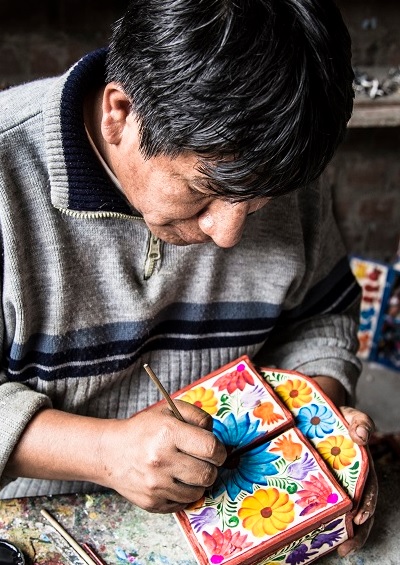Traditional Handicrafts in Peru
Civil strife has forced a craftsman from the mountains of Peru to live off what he can create with his hands.
March 26, 2016

Joanna Lindén-Montes was born in Finland in 1984 and is a Helsinki based photographer. She has a master’s degree in the history of art. She studied journalism in Peru, where she also worked for Lutheran World Relief.
She has travelled to various developing countries documenting the work of the Finnish Evangelical Lutheran Mission (FELM), where she currently works as a communications officer. In 2013 she served as an official photographer at the World Council of Churches 10th assembly in South Korea.
Mabilón Jiménez Quispe survives in one of Lima’s poorest areas thanks to his handicraft, making retablos, a folk art derived from traditional Catholic church art.
The floor of his workshop, on the roof of his family’s house in the Juan de Lurigancho neighborhood of the Peruvian capital, is cluttered with small wooden retablo boxes, some unpainted, others decorated with colourful flowers. The interiors of most of the boxes are filled with Biblical scenes in which Jesus, Mary and Joseph are portrayed as indigenous people, and lamas replace camels.
Mabilón was born in Ayacucho, an Andean city known for its handicrafts, into a family with a long tradition of making retablos. He fled to Lima after a Maoist guerrilla group, Sendero Luminoso (Shining Path), launched a brutal insurgency leading to tens of thousands of deaths in the highland region around the city at the start of the 1980s.
Mabilón sells his work in Peru and overseas. But the earnings from this time-consuming craft are meagre, and many other retablo makers have abandoned the craft to take up other work. Today, only around 50 families in Lima make retablos, just half of them working by hand as Mabilón does.
Text and photographs by Joanna Lindén-Montes
 Joanna Lindén-Montes was born in Finland in 1984 and is a Helsinki based photographer. She has a master’s degree in the history of art. She studied journalism in Peru, where she also worked for Lutheran World Relief, and has travelled to various developing countries documenting the work of the Finnish Evangelical Lutheran Mission (FELM), where she currently works as a communications officer. In 2013 she served as an official photographer at the World Council of Churches 10th assembly in South Korea.
Joanna Lindén-Montes was born in Finland in 1984 and is a Helsinki based photographer. She has a master’s degree in the history of art. She studied journalism in Peru, where she also worked for Lutheran World Relief, and has travelled to various developing countries documenting the work of the Finnish Evangelical Lutheran Mission (FELM), where she currently works as a communications officer. In 2013 she served as an official photographer at the World Council of Churches 10th assembly in South Korea.The Other Hundred is a unique photo-book project aimed telling the stories of people around the world who are not rich but who deserve to be celebrated.
The Other Hundred Entrepreneurs: 100 Faces, Places, Stories — the second volume in The Other Hundred series — focuses on the world’s everyday entrepreneurs. It captures the reality that small and medium-sized businesses, rather than tech billionaires or elite MBAs, contribute the majority of the world’s jobs, including half of all jobs in Africa and two-thirds in Asia.
The book offers an alternative to the view that most successful entrepreneurs were trained at elite business schools. Here are people who have never written a formal business plan, hired an investment bank, planned an exit strategy or dreamt of a stock market floatation. Some work for themselves, others employ a few people, still others a few hundred.
 The book’s 100 stories were chosen from a pool of 10,000 images shot in nearly 150 countries. The book is published by Oneworld Publications in London and is available in bookstores worldwide and online.
The book’s 100 stories were chosen from a pool of 10,000 images shot in nearly 150 countries. The book is published by Oneworld Publications in London and is available in bookstores worldwide and online.Takeaways
Civil strife has forced A craftsman from the mountains of Peru to live off what he can create with his hands.
Six photos depict the craftsmanship of a Peruvian man living off his work.
Civil strife in Peru forced many citizens to move to the coast. In photos, here is one mans story.





